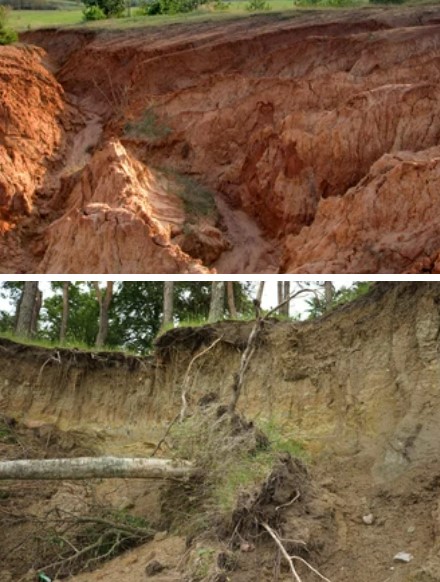Soil erosion happens when the top layer of dirt gets swept away by elements like water, wind, or even our own actions. When the top blanket of land is washed off, we also call it denudation.
People play a part in this problem by chopping down trees, digging up to get minerals, and grazing too much. Farming practices that are poorly executed can cause this problem as well.
But guess what, Mother Nature has her hand in it too. This happens through dry spells and deluges. Additionally, natural forces like wind and glaciers further worsen soil erosion.
Gullies
When running water carves its way through clayey soils, it creates deep channels called gullies. This results in bad land that cannot be cultivated.
Sheet Erosion
Sheet erosion occurs when water glides smoothly down a slope, casually sweeping away the topsoil in its path.
Wind Erosion
Wind can also carry loose soil from flat or sloping areas in a process called wind erosion.
Therefore, it's crucial for both humans and nature to protect our precious soil from degradation by properly managing resources and incorporating sustainable practices.
Summarizing Soil Erosion Due to Nature
Soil erosion by water occurs through various methods. One such method is sheet erosion, where a thin layer of soil gradually washes away.
Rill erosion happens when rainwater runoff creates tiny channels while flowing down a slope. These rills might be as deep as 0.3 meters. If they grow deeper than that, we call it gully erosion instead.
Gully erosion is another form, causing large gorges (deep channels) to form over time as water erodes the ground.
Leaching comes next in line--it's when rainwater dissolves and carries away nutrients from the soil.
Sea or shore erosion involves waves and currents wearing down coastal areas--removing sediments and rocks, while stream bank erosion takes place when water flows against riverbanks, undercutting and collapsing them.
Specifically put, when waterways exert stress beyond what local soil can withstand, stream bank erosion kicks in. As sediments pile up, swift currents carve and hollow out their banks in the downstream terrain.
In each case, Mother Nature shows her power to reshape landscapes for better or worse.
Summarizing Soil Erosion Due to Human Activities
In the Outer Himalayas, known as the Shiwaliks, deforestation occurs. This is also true for the Western and Eastern Ghats. Human activities are to blame for this loss of trees.
People remove plant life for various reasons, including making way for railways, roads, and structures or even farming.
In these regions, Sheet, Gully, and Rill erosion happen due to the removal of vegetation. Local dwellers practice shifting cultivation as well. This type of farming also contributes to erosion.
Similarly, uncontrolled animal grazing in valleys and on upper slopes leads to Sheet, Rill, and Gully erosion too.
With each passing day, nature struggles to find balance against these alarming human activities. It's crucial to acknowledge that teaming up to conserve our environment calls for mindful endeavors from each one of us. Only then can we ensure a sustainable coexistence both for humans and our surroundings.
Want these topics in animated form or in videos, you can contact NL.


